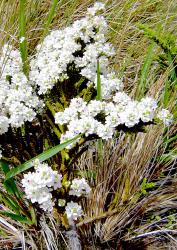- Taxon
- Gallery
- ≡ Hebe tetragona (Hook.) Andersen, Trans. New Zealand Inst. 56: 693 (1926)
- ≡ Leonohebe tetragona (Hook.) Heads, Bot. Soc. Otago Newsl. 5: 9 (1987)
- = Podocarpus dieffenbachii Hook., Icon. Pl. 6, 547 (1843) – as Podocarpus? dieffenbachii
Whipcord shrub to 0.6 m tall. Stems ascending to erect, glabrous except for a tuft of eglandular hairs at the connate leaf bases. Leaf bud indistinct, its outer leaves fully grown, diverging. Leaves opposite-decussate, connate in pairs and encircling stem, appressed and usually covering the well-marked node above, scale-like; lamina coriaceous, ovate to deltoid, 1.4–4.0 mm long, 1.5–4.0 mm wide, glossy olive-green above and beneath; veins not evident; surfaces glabrous; margin ciliolate, entire (incised to dentate in juvenile and reversion leaves); apex sub-acute or acute or acuminate; base broad; petiole absent. Inflorescence a terminal spike, 3.5–15.0 mm long; flowers crowded, 2–12, all bisexual; bracts opposite-decussate, connate, deltoid; pedicels absent. Calyx lobes 4–5 (5th lobe small, posterior), sub-acute to acute, equal, 2.0–3.2 mm long, usually eglandular-ciliate with long, deflexed, sinuous hairs, sometimes ciliolate. Corolla 5–6 mm diameter, tube white, 1.5–2.1 mm long, ≤calyx, eglandular-hairy inside; lobes 4, white, erect to recurved, sub-equal, ovate to broadly elliptic, 3–4 mm long, obtuse; nectar guides absent. Stamen filaments white, 3.3–3.7 mm long; anthers magenta. Style glabrous, 4–5 mm long. Capsule latiseptate, obtuse to truncate, 1.5–3.0 mm long, 1.7–2.4 mm at widest point. Seeds ellipsoid or irregular, flattened, smooth, pale brown, 0.9–1.5 mm long.
| 1 | Lamina 1.4–2.3(–2.5) mm long, not keeled or keeled at apex only | subsp. subsimilis |
| Lamina (1.8–)2–3.2(–4) mm long, strongly keeled and narrowed towards elongated tip | subsp. tetragona |
The distinction between V. tetragona and V. hectorii plants is slight and is discussed in detail by Bayly and Kellow (2006), along with discussion of various options for taxonomic treatment at species rank.
Plants of V. tetragona (North Island only) and V. hectorii (South Island only) can be reliably distinguished by the thickened leaf apex of V. tetragona, compared to that of V. hectorii, which is not thickened (Bayly & Kellow 2006, Fig. 48). The strongly tetragonous to cruciform leafy branchlets characteristic of subsp. tetragona plants also provide a clear distinction from V. hectorii, but the more rounded branchlets characteristic of subsp. subsimilis plants are not so easily distinguished. Although V. tetragona and V. hectorii plants are very similar, differences in flavonoid chemistry and distribution support their recognition at species rank (Bayly & Kellow 2006).
North Island: Gisborne (Raukūmara Range), Volcanic Plateau, Taranaki (Pouakai Range and Ruahine Range only), southern North Island (Kaimanawa Mountains, Kaweka Range, Ruahine Range, Tararua Range).
Sub-alpine shrubland and penalpine grassland.
| Category | Number |
|---|---|
| Indigenous (Endemic) | 2 |
| Total | 2 |
Hybrids with V. odora are quite common; they are whipcord-like, but with a larger lamina, and usually occur singly among populations of the parents.
Flowers: December–April; fruits: January–May, persisting all year.
2n = 40 (see Bayly & Kellow 2006).
Veronica tetragona is classified in V. subg. Pseudoveronica sect. Hebe and informally in the “Flagriformes” group, also known as “whipcord hebes” (Albach & Meudt 2010; Bayly & Kellow 2006).
Bracts and calyx lobes, but not the leaves, often have one to several longitudinal ribs, resembling the leaves of V. lycopodioides and V. poppelwellii plants.




